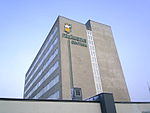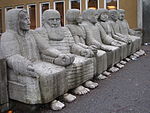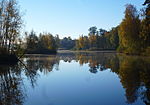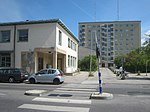Långbro Hospital

Långbro Hospital (Swedish: Långbro sjukhus), also called Långbro Asylum, was a psychiatric hospital in the Långbro neighborhood of Stockholm, Sweden. Långbro sjukhusmuseum, created by Heritage Stockholm, is a digital exhibit that preserves the history of the hospital.The grounds of the hospital are now preserved as a public park called Långbroparken. Amenities of Långbro Park include an ornamental pond with fountains, tree-lined avenues and walking tracks, lawns, playgrounds, community garden space, outdoor basketball court, outdoor circuit training equipment, gymnasium, swimming pool, preschool, and areas with old oaks left natural for wildlife to the western and eastern edges. Buildings in or near the park host small businesses and family homes.
Excerpt from the Wikipedia article Långbro Hospital (License: CC BY-SA 3.0, Authors, Images).Långbro Hospital
Stora Kvinns Väg, Stockholm Älvsjö (Hägersten-Älvsjö stadsdelsområde)
Geographical coordinates (GPS) Address External links Nearby Places Show on map
Geographical coordinates (GPS)
| Latitude | Longitude |
|---|---|
| N 59.280277777778 ° | E 17.974722222222 ° |
Address
Stora Kvinns
Stora Kvinns Väg 72-84
125 55 Stockholm, Älvsjö (Hägersten-Älvsjö stadsdelsområde)
Sweden
Open on Google Maps










